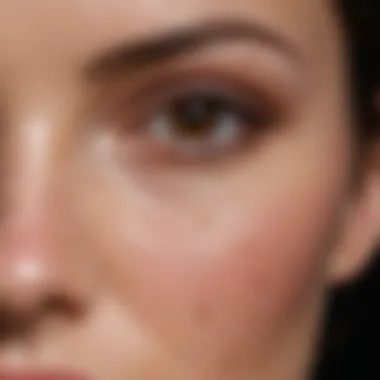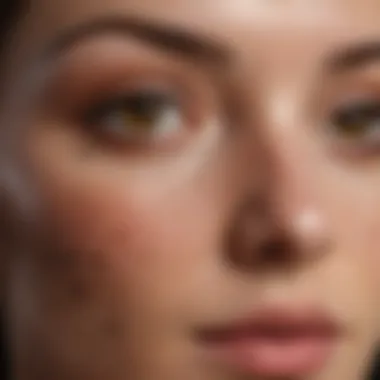Natural Remedies to Fade Brown Spots on Skin


Intro
Brown spots, also known as age spots or sunspots, can be a nuisance for many, marking skin with reminders of sun exposure and time. These spots may occur due to various reasons like prolonged sun exposure, hormonal changes, or simply aging. Whatever the cause, addressing them often leads to a quest for effective remedies. Fortunately, nature has provided an array of ingredients right in our kitchens or gardens that can help lighten these unwanted marks.
Let’s dive into some beauty tips and tricks to tackle brown spots effectively.
Understanding Brown Spots
Brown spots, often referred to as age spots or sunspots, can be a cause for concern for many individuals. The significance of understanding brown spots lies not just in their appearance, but also in the underlying factors that contribute to their formation. By grasping the nature of these skin changes and factors at play, individuals can gain insights into effective home remedies for managing and reducing their occurrence. This section provides a foundational understanding that empowers readers to take charge of their skin health.
What Are Brown Spots?
Brown spots are flat, pigmented areas predominantly found on sun-exposed skin, like the face, hands, and shoulders. While these spots can be harmless, they often serve as a reminder of skin's exposure to harmful ultraviolet rays over time. They arise from an overproduction of melanin, the pigment responsible for color in the skin, which can sometimes create patches of varying shades of brown. While brown spots appear as cosmetic concerns primarily, they can indicate the aging process or damage from UV rays. Understanding their nature is the first step towards effectively treating them.
Causes of Brown Spots
Brown spots are primarily caused by prolonged exposure to the sun, with harmful UV rays significantly impacting skin health. When skin is exposed to these rays, it reacts by producing more melanin to protect itself, leading to uneven pigmentation. However, sun exposure isn’t the only culprit on the scene. Other contributors include:
- Hormonal Changes: Fluctuations due to pregnancy or menopause can result in increased melanin production.
- Certain Medications: Some medications can heighten sensitivity to sunlight, leading to discoloration.
- Aging: As skin naturally ages, its ability to regenerate diminishes, making brown spots more noticeable.
- Genetics: Family history can play a role, as some individuals may be predisposed to develop these spots more readily than others.
Risk Factors
Understanding risk factors associated with brown spots is essential for prevention and management. Certain aspects can increase the chances of developing these spots:
- Skin Type: Individuals with lighter skin are often more susceptible due to less melanin protection.
- Geographic Location: Living in sunnier climates can escalate UV exposure.
- Lifestyle Choices: Frequent sunbathing, using tanning beds or lack of sun protection can compound the issue.
- Medical Conditions: Those with a history of skin conditions like eczema or psoriasis may also be at a higher risk.
Identifying these risk factors offers guidance for prevention and treatment, allowing individuals to select remedies tailored to their specific circumstances.
Natural Remedies for Brown Spots
Brown spots can be an eyesore and may affect skin's overall appearance. Many turn to commercial products, often loaded with chemicals, that promise to erase these blemishes. Instead, natrual remedies offer a safer and often more gentle approach to dealing with brown spots. These remedies are easy to find and can fit seamlessly into your daily routine. Using ingredients from your kitchen not only empowers you, it also connects you with centuries of natural healing traditions.
Natural remedies are important because they often come without the side effects associated with synthetic treatments. They can be nourishing for the skin, promote healthy cellular turnover, and provide antioxidants that combat free radicals. When you integrate these routines into your skincare plan, you may notice skin's radiance increase over time, tackling brown spots at their very roots. Let's explore a few of these remedies in depth.
Lemon Juice Treatment
Lemon juice is a robust natural remedy, known for its high vitamin C content and brightening properties. This citrus fruit has long been recognized for its ability to lighten hyperpigmentation. Applying lemon juice directly to affected areas can help lighten brown spots over time. Simply squeeze fresh lemon juice onto a cotton ball, apply it to your skin, and leave it on for about 10 minutes. Rinse with lukewarm water afterwards.
However, keep in mind that lemon juice can make your skin sensitive to sun rays. It's advisable to do this before a night’s sleep or ensure you apply some sunscreen the next day.
Aloe Vera's Role
Aloe vera is a true multitasker in the world of skincare. Not only does it soothe sunburns, but it has properties that can help reduce the appearance of brown spots too. The gel contains aloin, a compound that has been shown to lighten skin. For the best effect, apply fresh aloe vera gel to the discolored areas and leave it on overnight. This way, while you sleep, the gel works wonders on your skin.


Apple Cider Vinegar Applications
Apple cider vinegar, or ACV, is often hailed as a health superstar in the kitchen, but did you know it can also be beneficial for your skin? Its acetic acid content might help lighten brown spots. Mix equal parts of apple cider vinegar and water, and apply it to the spots. Let it sit for a few minutes, then rinse. Doing this a few times a week may show gradual improvement.
Turmeric and Its Benefits
Turmeric is not just a spice that adds color and flavor to your meals; it also contains curcumin, which has been studied for its ability to inhibit melanin production, thus potentially reducing hyperpigmentation. Create a paste by mixing turmeric powder with milk or yogurt and apply it to the affected areas. Leave it for about 20 minutes before rinsing off. The golden color may leave a slight tint, so it's best done when you don’t have any pressing engagements.
Vitamin E Oil Usage
Vitamin E is often regarded as a skincare powerhouse. It is known to enhance skin health, acting as an antioxidant that helps combat oxidative stress. Applying vitamin E oil directly to brown spots promotes healing and reduces discoloration. Simply puncture a vitamin E capsule and massage the oil over the spots, leaving it on overnight for best results.
Yogurt and Honey Mixture
Combining yogurt and honey creates a powerful duo for skin health. Yogurt contains lactic acid which can gently exfoliate the skin, promoting cell turnover. Honey, on the other hand, adds moisture and has antibacterial properties. Mix a tablespoon of plain yogurt with a teaspoon of honey and apply it to the skin. Allow it to stay for about 15-20 minutes before rinsing clean. Regular use could lead to a more even skin tone.
Always perform a patch test before trying new ingredients, especially if you have sensitive skin.
Incorporating these natural remedies can lead to significant improvements, turning your skin care routine into a holistic experience. Each remedy offers a different set of advantages, and finding the right mix might just be the perfect recipe for success.
How to Apply Remedies Effectively
Applying remedies correctly can make all the difference in achieving desired results when it comes to addressing brown spots on the skin. It's not merely about slapping a remedy on; it's about understanding the principles behind each step. The right preparation mitigates skin sensitivity, ensures better absorption, and maximizes the remedy's effectiveness. Here, we will explore the critical aspects of applying natural remedies through meticulous preparation, precise application techniques, and optimal frequency of use.
Preparation Steps
Before diving into any treatment, preparation is key. Taking the time to prepare your skin properly can significantly enhance the efficiency of the natural remedies.
- Cleanse Your Skin: Always start with a clean canvas. Use a gentle cleanser to remove dirt and oils, which can interfere with absorption. Avoid harsh soaps; instead, choose a mild option that respects your skin’s natural moisture.
- Exfoliation: Once cleansed, consider exfoliating. This can help eliminate dead skin cells, enabling the remedy to penetrate deeper. You could use a homemade sugar scrub or a store-bought exfoliant devoid of chemicals. Regular exfoliation, say once or twice a week, preps your skin wonderfully.
- Patch Test: It’s crucial to do a patch test, especially for those who have sensitive skin. Apply a small amount of the remedy on a discreet area and wait 24 hours. Watch for any reactions. If all is well, you can proceed with confidence.
Application Techniques
Even with the best remedy, improper application can lead to lackluster results. Here’s how to apply your chosen treatment effectively:
- Dabbing Rather Than Rubbing: When applying any remedy, employ a gentle dabbing motion instead of vigorous rubbing. This technique minimizes irritation and allows the remedy to settle into the skin comfortably.
- Use Clean Tools: If you opt for brushes or cotton pads, ensure they are sanitized every time. This step lessens the chance of introducing bacteria, which could worsen skin issues.
- Focus on Affected Areas: While it may be tempting to cover your entire face, prioritizing the brown spots can lead to better outcomes. Use a pointed Q-tip or your fingertip to target specific areas, applying just enough product without excessive layering.
"Less is often more, especially when it comes to skin treatments."
- Allow for Absorption Time: After applying, give your skin some breathing room. Let the remedy sit for a while before rinsing or applying anything else. Some remedies, like lemon juice or turmeric masks, may be left on for about 15-20 minutes to harness their full potential.
Frequency of Application
How often you apply these remedies ultimately shapes your results. Consistency is beneficial, but overdoing it might backfire:


- Start Slow: In the beginning, limit applications to two or three times a week. This rhythm allows your skin to adjust to the treatments without overwhelming it.
- Observe Your Skin's Response: After a couple of weeks, assess how your skin reacts. If all is well, you can increase the frequency gradually, possibly up to daily use, depending on the remedy and your skin's tolerance.
- Seasonal Adjustments: Your skin changes with the seasons. During hotter months, your skin may naturally be more sensitive, requiring a gentler approach. Adapt your routine to avoid irritation.
In sum, effectively applying home remedies requires thoughtful preparation, careful technique, and an awareness of frequency. Keeping your skin's needs in mind leads to healthier, more radiant skin over time.
Diet and Lifestyle Considerations
The significance of diet and lifestyle when it comes to managing brown spots on the skin cannot be understated. It’s not just about slapping on creams or using home remedies; it is also about the holistic approach to caring for your skin. Research suggests that what you consume and how you live can greatly influence skin health, including the presence of those pesky brown spots.
Importance of Hydration
Staying hydrated is a fundamental aspect for maintaining healthy skin. Water helps to flush out toxins and supports the overall function of the skin. Without enough hydration, the skin may become dry, leading to a more pronounced appearance of brown spots. A good rule of thumb is to aim for at least eight glasses of water daily, adapting based on physical activity, weather, and personal needs. Incorporating hydrating foods, like cucumbers, watermelon, and oranges, can also elevate your water intake naturally.
"Water is the essence of life, and keeping your body hydrated plays a crucial role in supporting skin vitality."
Nutritional Impact on Skin Health
What goes on your plate can be a game-changer for your skin. Nutrients like vitamin C, E, and omega-3 fatty acids are potent players in skin health. Vitamin C, found in citrus fruits, not only brightens the skin but also aids in collagen production, which is crucial for skin structure and elasticity. Foods rich in vitamin E, such as nuts and seeds, act as antioxidants, protecting the skin from damage.
On the other hand, foods high in sugars or refined carbs might exacerbate skin issues, potentially leading to inflammation and darkening of existing spots. Emphasizing a balanced diet with plenty of fruits, vegetables, lean proteins, and whole grains can help combat this. Here’s a list of beneficial foods:
- Citrus fruits (oranges, lemons)
- Leafy greens (spinach, kale)
- Nuts (almonds, walnuts)
- Fish (salmon, mackerel)
- Berries (blueberries, strawberries)
The Role of Sun Protection
The sun can be both a friend and a foe, especially for your skin. UV radiation is one of the leading causes of brown spots. Sun exposure triggers an increase in melanin production, which contributes to the formation of these spots. Hence, protecting your skin from harmful rays is vital. This includes wearing sunscreen daily, even when it’s cloudy, and opting for a broad-spectrum SPF of at least 30.
Also, wearing protective clothing and seeking shade during peak sun hours can mitigate the risk. Remember, sun protection isn’t merely a seasonal task; it should be a year-round commitment.
By being conscientious about hydration, nutrition, and sun protection, you enhance the efficacy of home remedies and support your skin's overall health. Adopting these lifestyle considerations not only aids in reducing brown spots but also contributes to healthier, revitalized skin.
Consulting Professionals
When it comes to tackling the issue of brown spots on the skin, seeking assistance from healthcare and skincare professionals can be a vital step. Many people might start with home remedies and natural approaches. However, consulting professionals brings a deeper perspective and significant advantages.
Professionals, like dermatologists, can provide tailored advice based on clinical experience and scientific understanding. They have access to cutting-edge technology and treatments, which often results in more effective solutions. Recognizing that brown spots can signify underlying health issues is crucial; therefore, having an expert opinion helps ensure that you aren't treating a symptom without addressing a possible cause.
"It’s not just about eliminating brown spots but understanding what your skin is trying to tell you."
When to Seek Help
Knowing when to consult a professional about brown spots can make a world of difference. If you notice changes in the color, size, or shape of brown spots, it’s wise to consult a dermatologist immediately. This is especially true if the spots are new or unlike any previous marks on your skin. A quick visit can ease your worries about possible skin conditions.
Additionally, if home remedies don't seem to yield results over a reasonable period, seeking professional help can also provide insights into why certain treatments may be ineffective. You might also consider visiting a professional if brown spots suddenly appear in large numbers or if there’s itchiness, bleeding, or discomfort associated with them.


Types of Treatments Offered
Various treatments are available through professionals, including but not limited to:
- Laser Therapy: A popular option that can target pigmentation effectively, lasers work by breaking down melanin in the skin.
- Chemical Peels: This involves applying a solution that removes the outer layer of skin, revealing a more even complexion underneath. It can be tailored to different skin types and concerns.
- Microdermabrasion: A minimally invasive procedure that exfoliates the skin to help lighten spots and improve texture.
- Topical Treatments: Prescription creams containing ingredients such as hydroquinone for hyperpigmentation or retinoids may be recommended.
- Cryotherapy: In this method, brown spots are frozen off using liquid nitrogen. It’s effective but might require multiple sessions.
The right choice of treatment often depends on the individual’s skin type, the nature of the spots, and any underlying conditions.
In summary, while home remedies can be effective for some, the insight and expertise provided by professionals can be instrumental in achieving optimal skin health.
Preventive Measures
Preventing brown spots involves a mix of daily skincare habits and being smart about your environment. This section emphasizes why taking proactive steps is as critical as the remedies discussed earlier. By adopting some simple yet important practices, you can significantly reduce the risk of brown spots forming on your skin.
Daily Skincare Routine Tips
Having a solid skincare routine is like building a fortress against potential skin issues. Here are a few tips to keep in mind:
- Cleansing: Start off with a gentle cleanser that helps remove dirt and oil without stripping your skin's natural moisture. Don't overdo it; twice a day should be enough.
- Exfoliation: Incorporate a mild exfoliant weekly. This helps slough off dead skin cells, which can contribute to the appearance of darker spots. Look for products with natural exfoliants, like sugar or ground oats.
- Moisturizing: Hydrated skin is healthy skin. A good moisturizer can keep your skin barrier intact. Look for hydrating ingredients like ceramides or hyaluronic acid.
- Sun Protection: Perhaps the most crucial step. Using a broad-spectrum sunscreen with at least SPF 30 daily is vital. Not just on sunny days, but every day, rain or shine. Reapply every two hours and more often if you’re swimming or sweating.
- Night Care: Don’t skip your night routine. Using products rich in antioxidants can repair and rejuvenate your skin while you sleep. Look for retinol or vitamin C serums to boost skin renewal.
Consistent care is your best shield against skin imperfections.
Clothing and UV Protection
When it comes to protecting your skin from sun damage, it’s not just about sunscreen. Your choice of clothing can also play a significant role. Here’s how:
- Sun-Proof Fabrics: Consider wearing fabrics with a UPF (Ultraviolet Protection Factor) rating. The tighter the weave, the better the protection.
- Wide-Brimmed Hats: Don a hat that shades your face, neck, and ears. A hat with a brim of at least 4 inches can be a stylish yet effective barrier against the sun.
- Sunglasses: Protect your eyes and the surrounding skin by wearing sunglasses that block 100% of UV rays. Look for oversized frames for added coverage.
- Light-Colored Clothing: Light colors reflect sunlight better than dark colors, so consider wearing these when soaking up rays.
- Layers for Outdoor Activities: If you’re heading out for a run or a hike, layer up with breathable long sleeves to minimize direct sun exposure.
By prioritizing these preventive measures, you can help safeguard your skin against the potential development of brown spots. It’s often said that an ounce of prevention is worth a pound of cure, and that couldn't be truer for your skincare journey.
The End
In wrapping up this article, it’s crucial to reflect on the various aspects we've discussed regarding brown spots on the skin. For many, these spots are not just superficial blemishes; they can carry emotional weight and affect self-esteem. By understanding the nature of these imperfections, we can better address them through a series of home remedies and lifestyle changes that are both accessible and effective.
Importance of Addressing Brown Spots
Brown spots, often known as age spots or liver spots, often signal prolonged exposure to the sun or skin damage. Hence, taking proactive measures can significantly improve one's skin health. Home remedies offer a gentle approach, utilizing natural ingredients that have been used for generations. This type of care minimizes potential side effects. Moreover, being aware of our skin's needs opens up avenues to enhance overall skin vitality and aesthetics.
Benefits of Home Remedies
Using home remedies for brown spots encourages us to rely on nature's bounty. Ingredients like lemon juice, aloe vera, or turmeric not only brighten the skin but are also cost-effective and easy to find in our kitchens. Besides focusing on topical application, integrating a holistic approach through diet and hydration is essential. Not to mention, preventive measures like utilizing sunscreen can save a lot of hassle in the long run.
Key Considerations
As you venture into addressing brown spots, remember that consistency is key. It's not merely about applying a product once; it's about incorporating a consistent regimen into your daily life. Ultimately, consulting with professionals when needed ensures you're not taking unnecessary risks, especially if the spots change or worsen.
"An ounce of prevention is worth a pound of cure."
Being proactive about skin care means understanding that results require patience and dedication. By adopting a comprehensive mindset—one that combines natural remedies, diligent skincare routines, and mindful lifestyle habits—you can significantly diminish the appearance of brown spots on your skin. Not only will this elevate your skin's look, but it will also foster a more profound connection to self-care and well-being.







